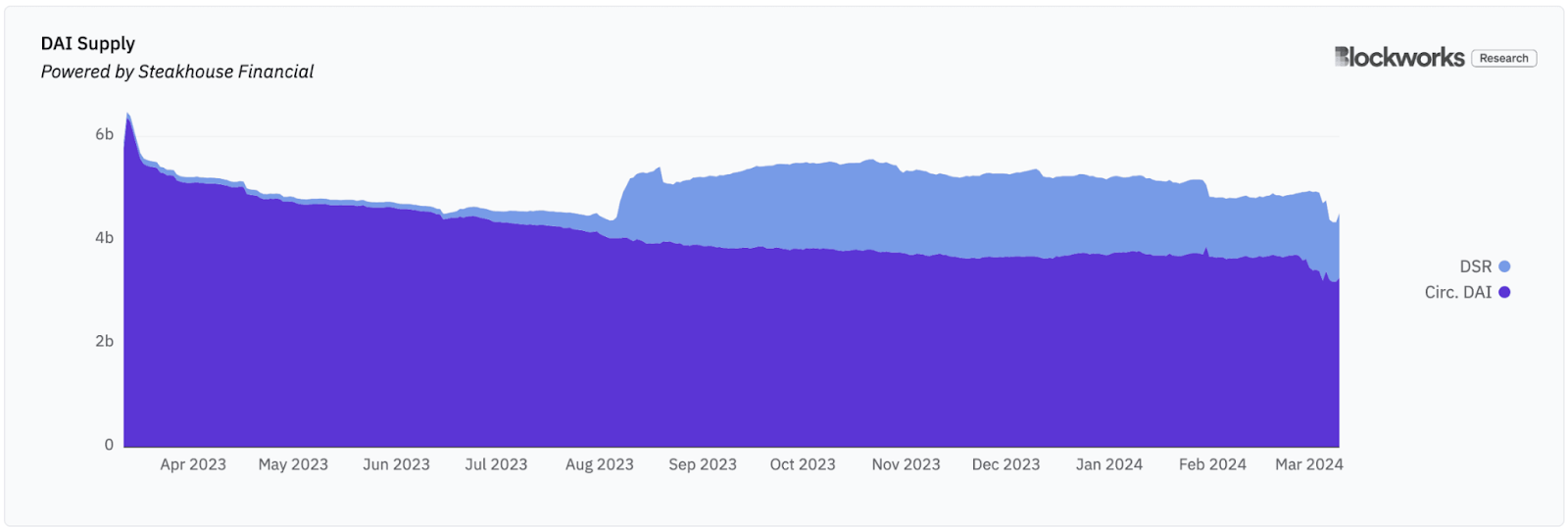MakerDAO, creator of the DAI stablecoin, has a good problem: Demand for its product is high.
SparkLend, a borrowing and lending platform organized as a sub-DAO within Maker, has issued so much DAI in recent weeks that it needs authorization to lend more.
In a governance vote approved Thursday at 12:00 pm ET, Maker voted unanimously to double the D3M maximum debt ceiling to 2.5 billion DAI.
“D3M” stands for Decentralized Debt Markets Module, a mechanism designed to optimize the DAI liquidity across different DeFi platforms. The module automatically adjusts the DAI borrowing rates on external platforms (like Aave) to be in line with the Dai Stability Fee within the MakerDAO system.
Read more: MakerDAO balance sheet now majority crypto-backed loans
Motivating the change is the rapidly accelerating demand for loans at SparkLend in the past week, which left available DAI falling to 250 million. Maker’s risk experts lobbied in favor of the increase, arguing there’s no need to keep it so constrained.
“With recent bull market conditions, it is becoming increasingly difficult to keep up with borrowing demand,” Monet-Supply, analyst with Block Analitica wrote on the Maker forum, noting that the protocol blew through its last debt ceiling increase and is growing at an average rate of around 20 million DAI per day.
“This poses a risk of unintentionally hitting the D3M maximum debt ceiling and artificially limiting Spark’s growth,” he wrote.
MakerDAO recently more than doubled stability fees across the board on March 10 following an executive vote. The Dai Savings Rate (DSR) jumped from 5% to 15%.
Stablecoin yield opportunities have been on the rise, leading traders to swap DAI borrowed at low rates for higher yielding USDC or other stablecoins used in DeFi.
For instance, in addition to promising high yields, a new entrant to the stablecoin market (Ethena’s USDe) is incentivized by a points-like system called “shards.”
Read more: Stablecoins need to focus on liquidity, not decentralization — Ethena Labs founder
That dynamic puts downward pressure on DAI’s dollar peg and pushed Maker’s PSM module, which allows swaps between DAI and USDC, down to record lows.

Read Blockworks Research: MakerDAO: Organic demand doesn’t grow on trees
Ethena co-founder, known as Leptokurtic, argued on an X space this week that his protocol’s contribution to Maker’s rate increase was overstated, noting that Ethena had captured less than 1% of the total value locked (TVL) in DeFi to date.
“I actually think the marginal impact that Ethena has had on these changes is probably less than people are giving credit for over the last few weeks,” Leptokurtic said. “These rate changes were going to happen with or without Ethena being there — it’s just now people make that connection a bit easier between rates in [centralized finance] and DeFi.”
Spark developer Sam MacPherson, CEO at Phoenix Labs, said during the same discussion that current rate levels are “almost certainly not sustainable” in the long run.
Read more: Spark Protocol is re-thinking stablecoin stability mechanisms
“Ethena is performing a great function here in bridging this disjointed rates behavior,” MacPherson said. “Maker is at the mercy of the market just as much as everybody else, it’s just that there’s no smart contract doing it, there’s more of a slower human process that people attribute agency to the rate setting within Maker — but that’s really not the case.”
For stablecoin holders right now, times are good, with many options to receive relatively safe double-digit yields.
The question is, how long can it last?
“You can’t have 30,40, 50% rates on USD that is sustainable,” MacPherson said. “Eventually [traditional finance] is going to come in on size,” and push rates back down.







Leave a Reply